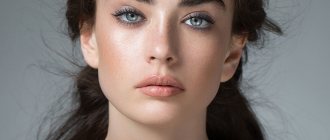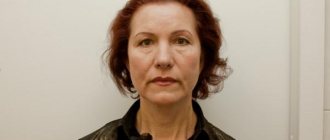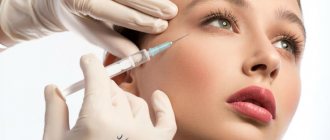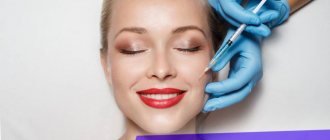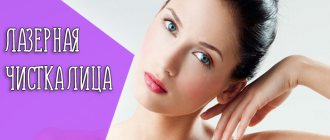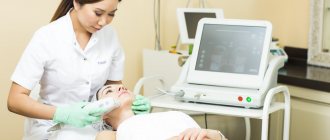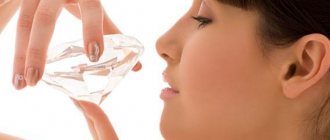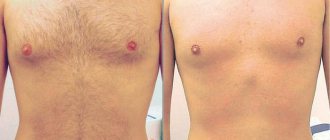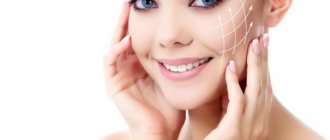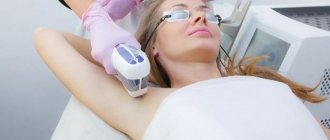Day 1: Intense hydration
The next day after the procedure, you may notice that the “lattice” effect of the skin has become more noticeable. The skin may have a brownish tint and feel rough to the touch. Don't worry, this is completely normal - this is how your skin recovers. The tiny dots you see are the healing process of the skin from the inside, from below.
Tiny white bumps may appear over the entire area of the skin - this is the appearance of thickened sebum. In a couple of days they will disappear on their own. Under no circumstances try to squeeze them out! Now your skin is too sensitive, and even the slightest pressure can greatly aggravate the situation. Just wait a little.
First thing after waking up in the morning, do cold soaks (we mentioned them above) for at least 30 minutes. This will help soften any crusts that may have formed overnight. After this, you can take a shower: let streams of lukewarm water flow down your face. Never expose your face to strong pressure of hot water. A gentle stream of water will help soften or even wash away the crusts. Wash your hair with a gentle shampoo - suitable for children.
After the shower, you need to do cold lotions again - for about 30 minutes. Then take one of your gauze napkins, soak it in warm water and gently remove those crusts that will be easily removed. Under no circumstances use any force when removing the crusts. After this, you can continue with cold packs if you want.
If you experience any discomfort—dryness, itching, or tightness—apply a non-comedogenic moisturizer (this can be done as often as you like. You'll probably need about 3 applications a day). Apply the cream with your fingertips or cotton swabs (be sure to wash your hands before doing this). It is not necessary to remove ointments or creams from the face before applying cold compresses.
In the morning after washing your face, be sure to apply sunscreen generously. Even if you don't go outside, your skin is still exposed to the sun's rays from windows or while traveling in the car, so protection is essential!
If your face is swollen, use any over-the-counter anti-inflammatory drug (such as Naproxen or Motrin). Most often, the skin under the eyes and around the lips swells. If this happens, there is no reason to worry: such swelling will quickly pass.
Before going to bed after the last round of lotions, apply the moisturizer generously again, making sure to cover all treated skin. To prevent your product from staining your pillow, place a towel on top of it.
To reduce puffiness and further protect your facial skin, it is best to sleep on your back with your head held high. Some people also advise taking two small towels, rolling them up and placing them to the left and right of your head - so as not to roll over in your sleep.
Differences between laser dermabrasion and photorejuvenation
Laser resurfacing: “before” and “after” photos
There are many different methods in hardware cosmetology, so laser resurfacing is often confused with photorejuvenation. But these procedures have significant differences. During photorejuvenation, the skin is exposed to pulsed light; during resurfacing, the skin is exposed to laser radiation, in which all beams have the same length.
When photorejuvenating the skin, it is worth going through more procedures than when resurfacing, since the procedure has a gentle effect on the skin. At the same time, it is considered safer, but does not solve serious damage to the skin. As a result of the procedure, there is a gradual renewal of the skin and stimulation of metabolic processes. In this case, the laser acts faster and more efficiently.
Day 2 – 7: Moderate hydration and sun protection
The swelling of the face should already have decreased, but a slight swelling may remain until the 7th day after the procedure.
Continue to apply moisturizer and sunscreen as needed. Your facial skin may still have a pinkish or brown tint. Once exfoliation begins, DO NOT rip anything off! The excess skin will fall off on its own as it heals, and if you force the exfoliation, you may be left with scars or areas of lighter skin.
If you notice any bumps, I repeat: do not try to squeeze them! If the laser encounters any excess substances in the pores during therapy, your body will get rid of all this itself during the recovery process. All the bumps that you are seeing now are things that could become inflamed in the future and appear as pimples. Your skin is hyper-sensitive right now, and any attempt to physically get rid of anything can ruin everything. Leave these bumps alone - and you will see how easily and quickly your skin will get rid of them during the cleansing and restoration process.
In the first week after the procedure you should not:
- Trying to “tear off” the skin, which is not yet ready for this.
- Trying to crush or scratch something.
- Stay in the sun for a long time.
- Use harsh skin care products: no products containing retinol, no exfoliators, no Clarisonic brushes. Products containing benzoyl peroxide, glycolic or salicylic acid are also excluded.
- Do waxing in the area that was exposed to the laser (you can carefully shave or pluck the hairs).
- Wash with hot water. Hot water itself will not cause any harm, but the feeling on the skin will not be the most pleasant. Now it is better to wash your face with lukewarm water.
What is laser resurfacing?
Laser resurfacing is a gentle vaporization (dehydration) of dead skin cells in problem areas, which triggers accelerated collagen synthesis and other regeneration processes.
Cosmetologists recommend this procedure for the following problems:
- decreased skin elasticity and other age-related changes;
- photoaging associated with prolonged exposure to the sun;
- pigmentation;
- uneven facial contour;
- dull skin color;
- fine wrinkles, which over time can turn into deep ones;
- stretch marks on the body;
- scars and scars.
All these problems can be prevented and their progression can be significantly slowed down with the help of laser resurfacing, after which the skin becomes smoother and more youthful, and a pronounced lifting effect is observed.
Laser resurfacing is rightfully considered the safest and most effective method of rejuvenation, being, in fact, a real alternative to plastic surgery.
Contraindications
Before and after photos of laser resurfacing
Despite the fact that laser resurfacing is a fairly safe and low-traumatic procedure, in some cases it is contraindicated.
Laser dermabrasion is not performed:
- during pregnancy and breastfeeding
- diabetes
- viral or infectious diseases (dermatitis and psoriasis)
- chronic diseases in acute form
- oncology
Hyperpigmentation after laser and spots on the face after resurfacing
Most often, hyperpigmentation after laser and spots on the face during grinding are temporary consequences, their appearance is explained by the activation of pigment-producing cells - melanocytes. This reaction usually disappears on its own within 3-4 months. Excessive pigmentation can be provoked by sunlight during the period until the skin has fully recovered. Therefore, it is strictly forbidden to go outside in the first 2 months without cream with a 50 SPF filter.
Laser skin burn and its consequences
Laser burns to the skin and its consequences (scars, suppuration, spots) are complications from peeling. Main reasons:
- the use of medications that increase sensitivity to light (antibiotics, antibacterial drugs, hormones and contraceptives, vitamins, dietary supplements, St. John's wort), therefore it is important to inform the doctor about absolutely all medications taken,
- recent tanning (up to 2 months) in a solarium or on the beach,
- individual skin sensitivity,
- dark, dark skin tone,
- use of perfumes, essential oils, cosmetics,
- incorrect device settings, poor contact with the skin, lack of cooling in the device.
The first stage of a burn is characterized by pronounced redness. It often appears after the procedure and ointments (Solcoseryl, Bepanten) are sufficient for therapy. With a more severe reaction, blisters and sores are possible. This complication cannot be treated on its own; consultation with a dermatologist is required.
What is a fractional laser procedure?
The cosmetology field is developing more and more actively over time. Methods for treating various structural disorders of the epidermis are not only surgical or traditional interventions, but also conservative hardware ones. Various physical phenomena are used to change the structure of the skin:
A fractional laser is a point beam of a large amount of energy that heats the inside and extracellular fluid at a certain depth (depending on the wavelength), initiating evaporation and thermal burn or the release of biologically active substances.
For a visual representation of this process, you can familiarize yourself with a large number of resources, rich photos and videos of this treatment method.
Depending on the method of exposure, ablative and non-ablative lasers are distinguished. The main distinguishing feature between them is the ability to initiate ablation (evaporation) of the outer layer of the skin.
Due to its long wavelength, an ablative laser has low penetrating ability; therefore, all the energy accumulates in the surface layers relative to the beam and has a damaging effect in the form of cell evaporation. The result is a deep wound that exposes the inner layers of skin. Currently, carbon dioxide laser is used.
Non-ablative lasers have a shorter wavelength, which increases penetration and allows you to choose the depth of the effect. Unlike ablative, cell destruction does not occur. A typical representative of this type is the erbium laser.
As a result of exposure to fractional lasers, they stimulate the production of specific proteins that perform the following roles:
Fractional laser methods are used in the treatment of the following diseases:
- Disorders of skin pigmentation (melasma, lentigo).
- Structural pathologies of the epidermal layer of the skin.
- Pore expansion.
- Scarring.
- Stretch marks.
- Significant increase in the number of folds.
- Age-related changes (significant decrease in turgor with the formation of wrinkles of moderate depth).
- Acne and post-acne, stretch marks.
Contraindications
The laser has a significant effect not only on a limited area of the skin, but also on the entire body, causing damage. To successfully restore a damaged structure, various systems are involved, therefore, for high efficiency of the procedure with a low probability of unwanted effects, it is not recommended to perform this procedure for people with certain pathologies.
Among the diseases and conditions, there are those in which under no circumstances it is impossible to carry out the procedure (absolute) and those in which it is possible to carry out photothermolysis after cupping (relative). The absolute ones include:
Relative contraindications include:
- Allergic reactions to taking local analgesics.
- Disruption of the excretory system.
- Similar procedures performed in less than 2–3 months for the dermal layer and in 10 days for the epidermal layer of the skin.
- Autoimmune connective tissue diseases.
Complications
After laser resurfacing of the face, a burn occurs, characterized by pain, burning, and itching. Undesirable pathological symptoms after a fractional laser procedure can occur either if the principles of therapy are not followed, or if the patient ignores adequate postoperative skin care. The risk of complications is extremely unlikely.
Among the pathological reactions are:
Deep face resurfacing under general anesthesia and its consequences
General anesthesia can be used for deep resurfacing of the face and eyelid area. This helps to avoid pain and guarantees complete immobility, which improves the result of the procedure. However, it is important to know the consequences of general anesthesia:
- pressure drop,
- disturbances of blood circulation, heart rhythm, breathing, kidney and liver function,
- increased intracranial pressure - nausea, vomiting, severe headache,
- dry mouth,
- allergic reactions.
Most of them can be avoided with a preliminary examination. Therefore, when choosing an operation under general anesthesia, be sure to consult a therapist in advance and obtain an opinion on the possibility of such anesthesia. The choice of the clinic, the specialist who will carry out the resurfacing, and the anesthesiologist is also important.
Watch this video about how laser facial resurfacing is performed under anesthesia and what is done to quickly heal the skin:
